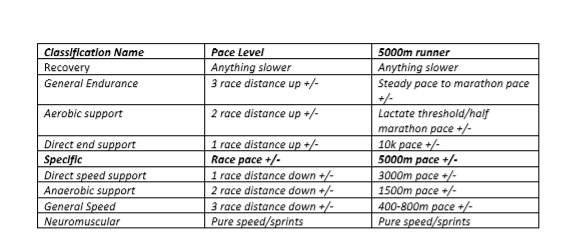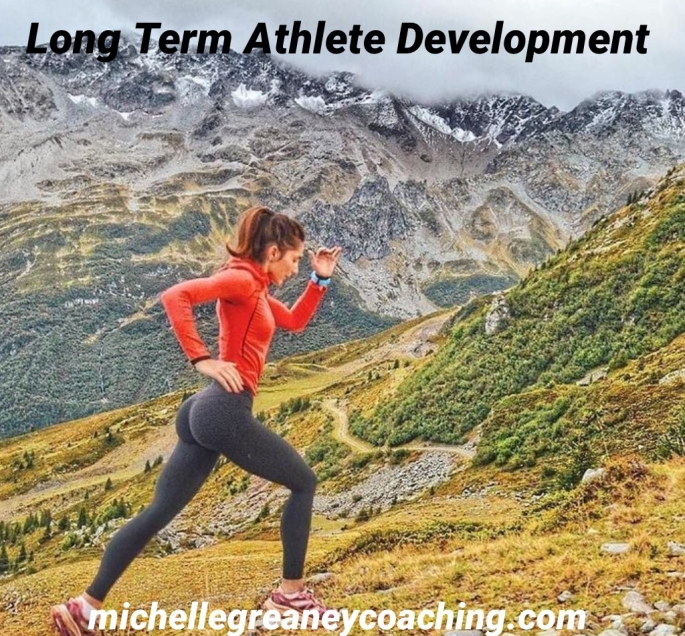Unfortunately, few parents and coaches approach training with an attitude best characterised as peaking by Friday where a short-term approach is taken to training and performance with an over emphasis on immediate results .
It takes 10 years of extensive training to excel in anything
Herbert Simon Noble laureate
A specific and well-planned practice, competition and recovery regime will ensure optimum development throughout an athlete’s career. Ultimately, sustained success comes from training and performing well over the long term rather than winning in the short term. There is no shortcut to success in athletic preparation. Overemphasizing competition in the early phases of training will always cause shortcomings in athletic abilities later in an athlete’s career.
For proper development of middle- and long-distance athletes, we can separate development into 3 main phases:
Foundation (F)-Introducing the skill sets needed to train, enjoyment, establishing good habits-skill and movement development, ability to move in all planes of motion. If we take care of this early on, it allows for greater room for growth in terms of efficiency later down the road.
Development (D) -Establishing all skill sets and training ingredients into the programme, beginning individual differentiation, training to be able to train. Emphasis here shifts from purely movement to learning how to express their speed and power. From short sprints focussed on acceleration and top end speed to lengthening their ability to hold their mechanics together for longer periods of time, slightly shifting into a speed endurance emphasis while maintain top end speed. More structure is added to the training and high-end aerobic development is expanded on with introduction of short tempo, fartlek (e.g. 5-10 x 30sec pickups at 3k effort) and other aerobic workouts. It is very important to slowly introduce and progress high intensity work.
Performance (P) – Assembling those ingredients and making sure they grow, training to perform.
The ingredients can be classified into:
Movement and neuromuscular development
~biomechanics (F)
~strength, power and neural work (P)
Psychology and Motivation
~Motivation for training (F)
What fuels the desire for success? (D)
Grit, toughness and resiliency (P)
Ability to handle stress (P)
Training and conditioning
We have a whole range of intensities that cause different adaptations along a continuum and what shifts is the emphasis
Specific
⇑ ⇑
Direct end support Direct speed support
⇑ ⇑
Aerobic support Anaerobic support
⇑⇑⇑ ⇑⇑⇑
General Endurance General Speed
General emphasis shifts over time, initially, there is a heavy emphasis on creating a foundation across all spectrums (speed, endurance, neuromuscular, movement and the psychological side of development). Early on, the training focus is on general athleticism, experimentation here also is key with the idea of developing competencies that they can build off. As the athlete develops, there is a gradual shift towards specificity, with running and, endurance development, taking precedence. We don’t want an athlete specializing too soon.
As the athlete’s career progresses, the emphasis shifts from purely movement, to learning how to express their speed and power. The introduction of short sprints focused on acceleration and top end speed should be done first. This should be followed by looking at how to lengthen their ability to hold their mechanics together for longer periods of time, slightly shifting into a speed endurance emphasis, while maintaining top end speed.

The goal for long term athlete development is to bring the athlete along gradually:
Focus on the extremes before connecting!
Build general speed and endurance before trying to bring those qualities together with high loads of mixed high intensity work. We do this because we want to build an entire foundation from both ends of the spectrum before we can start building off it.
Very gradually progress volumes and intensities, we don’t want to see huge jumps in volume in endurance athletes. However, how an athlete adapts drives the training progression. If an athlete is improving at a strong level and has not hit a plateau, they are still adapting to the training load. On the other hand, if they are stagnating and plateaued (and not because of overtraining), it may be time to look at a change in volume, intensity or type of training sooner than planned.
Short term periodisation
Yearly periodisation is a condensed version of a long-term plan that looks at progression through the 4 stages in the year. The goal is to put the pieces in place early in the year before assembling them later. Exact periodization needs to be adjusted to the racing schedule, emphasis and to the individual athlete.
Principles for planning the year remain the same for ever individual:
1. All components are there, throughout the periodisation scheme, we just need to change the emphasis based on whether we are building or maintaining a component.
2. We are either building, maintaining or connecting! We spend more time building a component (both on speed and endurance side) as it takes more of an effort than maintaining it. That means a focus early on at the extremes (easy to moderate work and pure speed/biomechanics development). As we progress, we work on slightly faster aerobic work and slightly longer speed/anaerobic work). Once we shift towards emphasizing a different component, we need to do just enough to maintain it. Connecting means transitioning from one component to the next, bridging the gap. E.g., using mixed workouts where we are progressing through a range of speeds.
3. Our emphasis should funnel towards specificity as we progress towards our racing fitness.
4. Stress and adaptation, supercompensation effects. Training needs to be modulated based on stress and recovery cycles-depending on the individual and training age. Our Emphasis should funnel towards specificity.
5. As we progress towards our racing fitness, we need to move from general speed and endurance to specificity.
6. Adhere to our knowledge of stress and adaptation.
7. Recognize that we need to modulate training based on stress and recovery cycles which, again can depend on the individual and training age. What that also means in terms of putting training details together is that we need space between harder, more-stressful sessions. Occasionally, we might load up stresses to get a large supercompensation effect, but those are performed rarely and for special reasons.
https://wordpress.com/block-editor/post/michellegreaneypt.wordpress.com/436
Individuality is extremely important. Every athlete is physiologically and psychologically different which affects the way they handle their training and how training should be adjusted accordingly. Their natural inclinations will subtly shift what their strengths and weaknesses are which in turn shifts the way they handle their training.
Classification of athletes is a two-step process. First, we need to identify whether they are more Fast – Twitch (FT) or Slow – Twitch (ST) orientated athletes. This will help us decide whether to route them into the middle or long-distance events. We can then further subdivide our athletes into being more FT or ST orientated for the events they compete in.
To begin the classification, data must be captured that will give us an idea on their natural speed and endurance qualities. We can then compare both sides of the coin and see where they predominate. A FT orientated athlete is going to show a proclivity towards speed qualities. For example, he or she might perform better in power testing, short sprints, or have higher lactate levels during an anaerobic capacity test. The following methods can be used to classify athletes.
-Lactate testing
-VO2 testing
-Power/strength testing
-Workout and race event comparison
Adjusting training based on athlete classification is important. The differentiation of training will increase as they specialise. Early on, the training is similar among FT and ST athletes, but as they develop, it becomes more individualised. From a training perspective, the idea is to maximise the athlete’s strengths, playing towards their physiology, while at the same time making sure their weaknesses do not become a limiting factor. We always need to see if we can train the weakness and shift the limiting factor!
I like to use a short to long concept, a training strategy where athletes first achieve peak form in a short distance before extending the length of their repetition.
Trainability and Recruitment
Understanding how trainable an athlete’s basic physiology and capacities is very important when identifying potential athletes. It is one thing to have a high aerobic capacity early on but what effect does training have on it. There area several ways to tackle this problem,
We can use a staple test workout or time trail at the beginning and end of training period and to track improvement. The key is using two tests that are heavily dependent on speed and endurance and will reflect changes in training. The absolute performance is not what we are after, instead, we need to look at the improvement from beginning to the end of the training intervention. We can also utilize physiological testing to see how parameters change.
The training during this period should focus on the two parameters that influence performance the most, speed and endurance. For that period, given the age of the athletes, the training should be focused on either extreme- speed and endurance.

